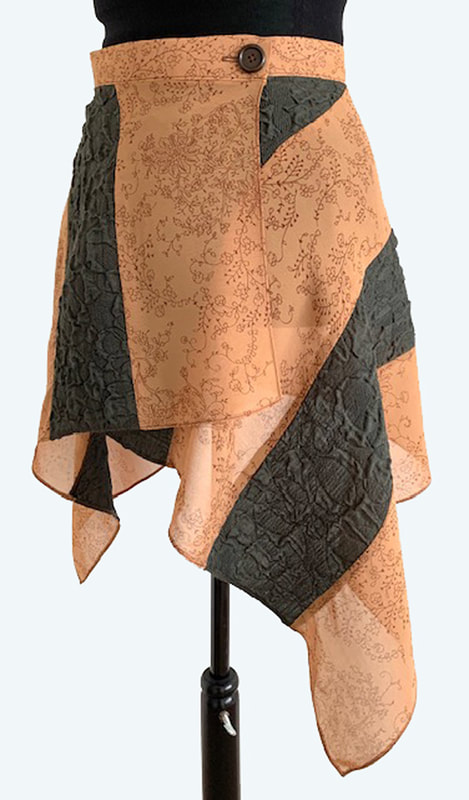|
Observing the concentration in Alberto Atalla’s class was a joy. “Fold 1 cm in here and 1 cm in there and then iron it. Then you can top stitch. Fold over the end and stitch – you can tuck it inside or leave out. You can stitch by hand or do embellishment – it’s your design! I’ve done a zig zag in here and a zig zag in there”, he explained to the group. The students all had a think and looked again at the examples as they took control of their choices of design for this delightful wrap skirt. Who would have thought from a single set of measurements that you could make so many different skirts? Students had all cut their skirt designs without a pattern, using measurements taken earlier in the day and working directly onto the fabric. Following step by step instructions with carefully prepared samples, Alberto’s six students were on a mission to create an individually designed wrap skirt for any occasion. There were festival skirts, embellished felt wraps, long beach draping versions and dinky little Summer numbers that swirl and spin in the breeze! You could make a more formal version too – the choices were seemingly endless. And all a perfect fit of course, as the cutting element of this class meant each one was bespoke to the wearer. “What did you make your strings out of?” one asked. “Just the spare material from the main skirt body” another replied. Students talked amongst themselves showing each other how they had tackled some of the elements of the design. Others were so engrossed in the work that they ignored the lunch bell altogether! All the students made the first cut from calico – a lightweight and inexpensive material that is really easy to sew and to work with. Then they can get started on their actual designs once the pattern is a perfect fit and style. “He’s even got us doing school maths” one student confided! On the blackboard was a lovely set of calculations using Pi to get the right diameter aperture for the waist….. This was a great workshop that really got both the brain and the hands working, and all students gave Alberto EXCELLENT scores for his patient and inspiring tuition. We can’t wait for Alberto to return with his next exciting project!
0 Comments
I gate-crashed an interview which Sue Pearl was giving to one of her students recently. Hannah Lithgow, the keen student, was studying for her A levels including A level Art, along with Biology and Geography. As part of this, Hannah's doing an EPQ (Extended Project Qualification) in Dyeing with Flower Pigments on Silk. She was looking at how effective certain methods of mordanting are, amongst other nuances of technique, and had some hypotheses to test with Sue, the seasoned expert in this field. The conversation was fascinating. I was listening in to an eager young mind, wanting to push the boundaries of eco-dyeing techniques, experimenting with both new and traditional ways of doing things.
We were joined at Ardington School of Crafts in September by the delightful Richard Box for another exposé of his artistic talents. He is so popular with our students, whether for his Drawing for the Terrified, Painting for the Petrified or Machine Embroidery (also known as free-stitching) courses, and it’s easy to see why. Richard has a very easy going and fun style of teaching that it is difficult not to love!
Here’s how he describes today’s Daisies workshop: “I show the students how to start by whizzing about on my sewing machine. Go slowly I say, breathe and smile radiantly while you are at it! The smiling means they don't jerk – you need a nice, smooth action for this work”. Richard is hardly going slowly at this point as he demonstrates, but then he has been practicing for a few years now, and he makes it look so simple. With the correct foot for your sewing machine (a darning or free-motion foot), you really can whizz up an exciting piece of stitchery. Do you know your warp from your weft?
There’s an easy way to remember which is which. Weft goes Left to Right, so that means the Warp is the one that runs vertically through the fabric, and generally needs to be stronger because it gets stretched onto the loom. Our expert weaver, Angela Pawlyn, talks through how she got started in weaving and what influences her work. Angela got started when she and her mum went to the lake district after her father died. Her mum started to study weaving, spinning and natural dyeing, and Angela has since taken on all of her mum’s equipment and is now a prolific weaver. She has done some work with Martin Weatherhead, a full-time designer craftsman in Pembrokeshire who teaches weaving. His methods of threading up the loom are the ways which Angela has adopted. |
Blog categories
All
Author:
|
























 RSS Feed
RSS Feed